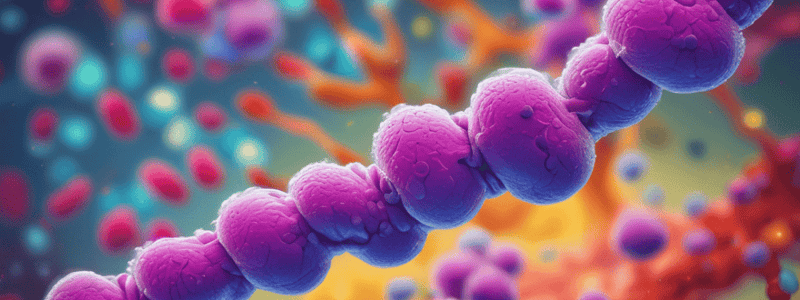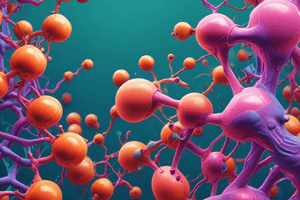Podcast
Questions and Answers
What is the definition of hormones according to the text?
What is the definition of hormones according to the text?
- Chemical substances that regulate the activity of other tissues
- Chemical messengers released from ductless glands into the bloodstream that regulate the activity of other tissues (correct)
- Substances released from ductless glands into the bloodstream
- Messengers that regulate the activity of other tissues
Which of the following is not a classification of hormones based on their chemical nature?
Which of the following is not a classification of hormones based on their chemical nature?
- Peptide or protein hormones
- Lipid hormones (correct)
- Steroid hormones
- Amino acid derivative hormones
Which hormone is an example of a peptide or protein hormone?
Which hormone is an example of a peptide or protein hormone?
- Testosterone
- Thyroxine (T4)
- Glucocorticoids
- Insulin (correct)
Which hormone is an example of an amino acid derivative hormone?
Which hormone is an example of an amino acid derivative hormone?
Which type of hormone action is mediated via intracellular receptors?
Which type of hormone action is mediated via intracellular receptors?
Which second messenger is used by hormones that act via cell surface receptors?
Which second messenger is used by hormones that act via cell surface receptors?
Which hormone uses cyclic adenosine monophosphate (cAMP) as its second messenger?
Which hormone uses cyclic adenosine monophosphate (cAMP) as its second messenger?
Which hormone uses cyclic guanosine monophosphate (cGMP) as its second messenger?
Which hormone uses cyclic guanosine monophosphate (cGMP) as its second messenger?
Which type of hormone receptors are located on the cell surface?
Which type of hormone receptors are located on the cell surface?
What is the main difference between Group I and Group II hormones in terms of their mechanism of action?
What is the main difference between Group I and Group II hormones in terms of their mechanism of action?
Study Notes
Hormone Classification
- Hormones are chemical messengers released from ductless glands into the bloodstream, regulating the activity of other tissues.
Classification by Chemical Nature
- Peptide or protein hormones: insulin, glucagon, antidiuretic hormone, oxytocin
- Steroid hormones: glucocorticoids, mineralocorticoids, sex hormones
- Amino acid derivatives: epinephrine, norepinephrine, thyroxine (T4), triiodothyronine (T3)
Classification by Mechanism of Action
Group I Hormones
- Examples: glucocorticoids, estrogens, progesterone, mineralocorticoids, calcitriol, thyroxine
- Action is mediated via intracellular receptors
Group II Hormones
- Action is mediated via cell surface receptors and second messengers
- Hydrophilic in nature
- Divided into three categories depending on second messengers:
- Using cyclic adenosine monophosphate (cAMP) as second messenger: ACTH, FSH, LH, PTH, adrenaline
- Using phosphatidylinositol/calcium as second messenger: TRH, GnRH, gastrin, CCK
- Using cyclic guanosine monophosphate (cGMP) as second messenger: ANP
Studying That Suits You
Use AI to generate personalized quizzes and flashcards to suit your learning preferences.
Description
Learn about the classification of hormones based on their chemical nature, including peptide or protein hormones, steroid hormones, and amino acid derivatives. Explore examples of each type of hormone and understand their role as chemical messengers in the body.




